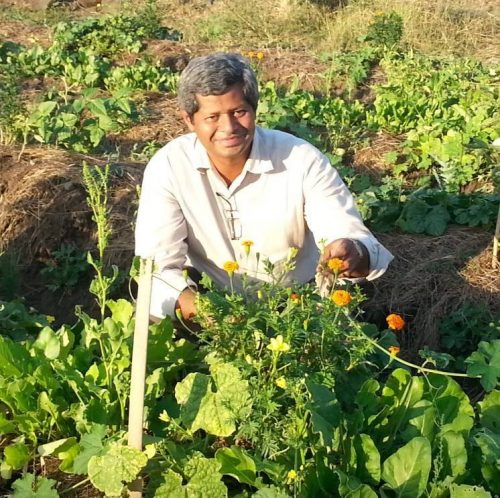From having a successful business to giving it up at the age of 50, from selling furniture to becoming a farmer – this is the amazing story of Suneet Salvi.
“People have family lawyers and family doctors – I want to work towards people having family farmers. People should know who is growing their food and how it is being grown,” says 53-year-old Suneet Salvi who recently gave up his lucrative furniture business to take up ‘natural’ farming.
He is now working with young tribal farmers in Murbad village of Dahanu Taluka located north of Mumbai.
The agriculture bug bit Suneet, a Mumbai resident, after he turned 50 and started thinking about what he wanted to do for the next 10-15 years of his life. “I was running a business and kept thinking if it was something I wanted to continue doing. The answer was ‘no’ each time. When will I have the time to do what I really want to, I thought. This was when I decided to break away from the regular routine to do something that matters and would give me satisfaction. It had to be bigger than just myself and my family,” he says, adding that he was always passionate about nature and wanted to do something in the field of agriculture.
“Many people do regular agriculture with chemicals, but they ruin the soil on a daily basis. I wanted to do the kind of farming that would help rejuvenate the soil and enhance its quality.”
It was by sheer chance that he met Pratik Dhanmer, an architect who lives with his family in Murbad. Pratik was a guest professor in the college where Suneet’s daughter studies and she had visited his village for a project. When Suneet started looking for land, his daughter introduced him to Pratik. They found that they had many common goals and started looking for land around Mumbai together.

“On visiting Murbad one day, I found that there were acres and acres of barren brown land that no one was farming. Pratik informed me that the villagers only cultivate paddy and the land goes unused from November till the next monsoon season. There are many reasons for this – shortage of funds, lack of confidence among farmers about where they can sell their produce, etc. Since we were looking for land anyway, we decided to work with these people instead,” says Suneet. The idea thrilled Pratik too because he had been trying to work with farmers on something similar.
It also turned out that young people in the village were not interested in going to the cities and wanted to find some source of employment in the village itself.
After about eight months of building trust among the farmers, Suneet finally started farming on a four-acre piece of land in January this year. The land belongs to the farmers.
We are trying to do natural farming, which is different from organic farming. In natural farming, you try to use everything available in and around the farm itself, as your input. And we have started with the aim of doing community farming. We want farmers to take whatever they learn on this farm and do the same thing on their own land too. We can sell their produce together as a community,” says Suneet.
While Pratik focusses on paddy farming, Suneet works on making sure their farming methods don’t harm the ecology in any way, and that the quality of soil and water improve.
“We don’t use any chemical fertilizers or pesticides and use as little plastic as possible. We work in harmony with nature to repair and improve the ecology. We have to prove to the villagers that farming does not require inorganic fertilizers and poisonous pesticides,” he says. They have also dug a percolation pond so that water that runs away from the farms can accumulate in it, percolate into the ground, and help increase the level of ground water.
Together, they are growing turmeric, ginger, papaya, drumsticks, etc., through multi-cropping, which Suneet says is the natural way of farming.
“Since this is traditionally a paddy field, we made high beds and planted vegetables like radish that grows underground; spinach, cabbage, fenugreek, and water melon that grow just above the ground; chillies, tomatoes, cluster beans, and corn that grow above the ground; and climbing creepers like sponge gourd, ridge gourd and cucumber.” He lives in the village from Monday to Thursday but leaves most major decisions in the hands of the farmers to make them independent.
“These are simple people. They grow one crop a year and either spend the rest of the time doing nothing or go to the city for menial jobs. My idea is to help them make farming sustainable and profitable. Right now, I am paying them for learning and working on our farm. In a year or so, they should be able to till their own land,” Suneet adds.
He is currently self-funding the project but hopes to turn profitable by selling the farm produce soon.
Suneet and his team also recently worked on desilting the village pond. The capacity of the pond has increased from 50 lakh litres to 85 lakh litres, and the water that used to finish by April every year, now lasts throughout the year. Dr. Ajit Gokhale, a Mumbai-based botanist and water specialist helped him in this project and has also been guiding the team with tips on farming and water conservation.
Suneet’s advice to people who want to do natural farming? “Work in harmony with nature and mimic it as much as possible. Restore the soil quality by mulching and using cow dung and urine. Create a micro-climate for the soil organisms and earthworms to thrive and multiply in. Do multi-cropping and always keep your soil covered with mixed dry mulch or live mulch. For ideal yield, the Carbon to Nitrogen (CN) ratio should be 10:1. It also helps to read books on the subject or attend seminars,” sums up Suneet, who has attended some workshops in natural farming himself.





Leave a reply